The best crypto mining software are CGMiner, BFGMiner, MultiMiner, Awesome Miner, EasyMiner, Kryptex Miner, MobileMiner, Cudo Miner, and NiceHash. Crypto and Bitcoin mining software is a program that connects your hardware to the blockchain and manages your mining process. It helps you solve cryptographic puzzles and send results to earn rewards.
This guide will review the best cryptocurrency mining software to explain features and which ones are most profitable for miners like you. We will also provide a clear guide on what crypto mining software does, how to choose the right one for your setup, and whether you can really mine 1 Bitcoin per day.
1. CGMiner
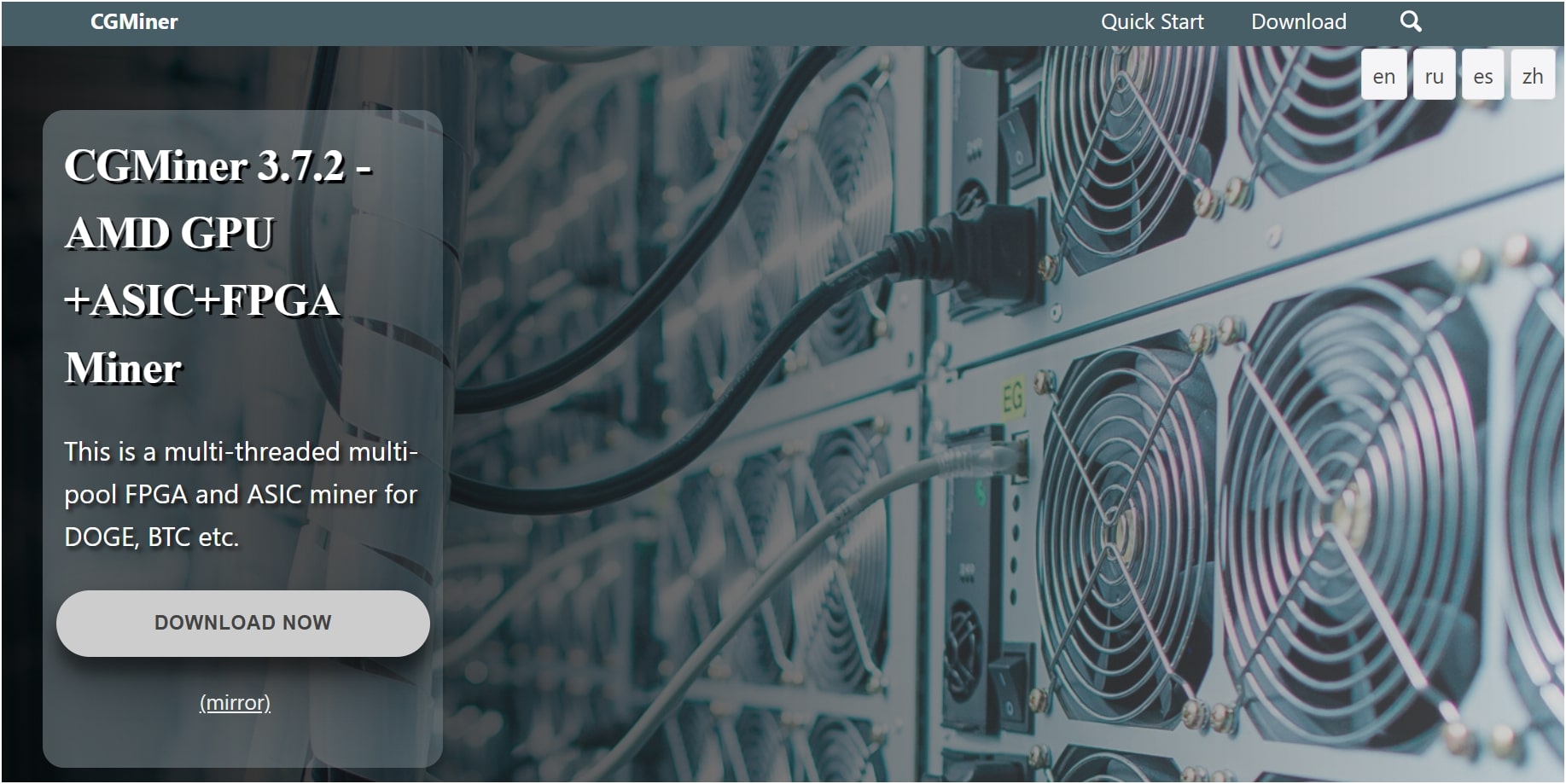
CGMiner is one of the oldest and most popular mining applications. It was launched in 2011, and this open‑source program keeps evolving thanks to a dedicated community. Today, you can run it on Windows and Linux, and it’s built in C, so it’s light on system resources. The software started out supporting GPUs and FPGAs, but modern versions focus more on ASIC hardware because, you know, GPUs aren’t efficient for Bitcoin anymore.
Open source and versatile: Being open source means you can review its code or modify it if you have technical skills, and that transparency actually helps people trust it. It supports different mining hardware, which makes it adaptable to various setups.
Advanced controls: CGMiner lets you easily adjust fan speeds, voltages, and core frequencies. Also, there’s an option to set temperature targets so the system slows down if it gets too hot. Hence, these features help you squeeze extra efficiency from your ASICs.
Flexible pool management: You can configure multiple pools and set backup pools. Also, if the primary pool goes offline, CGMiner switches automatically, and this failover system keeps your miners working instead of sitting idle.
Supported cryptocurrencies to mine: CGMiner is basically designed for you to mine cryptocurrencies that use algorithms like SHA-256, Scrypt, NeoScrypt, and CryptoNight. So, it can be used to mine Bitcoin, Dogecoin, Litecoin, and Dash.
2. BFGMiner

BFGMiner emerged in 2012 as a spin‑off from CGMiner. The initials stand for “Bitcoin Funder Group Miner,” and the software lives up to the name by giving users granular control over mining activities. Similar to CGMiner, it’s also open source, written in C, and compatible with Windows, Linux, and macOS.
It uses a text‑based interface and requires manual configuration. However, the software’s support for FPGAs and ASICs makes it a top pick for advanced users, and also, if you prefer to run multiple coins or want to experiment with different algorithms, BFGMiner offers that flexibility.
Modular design: BFGMiner uses modules for handling different hardware, and this makes it easy to add support for new ASIC or FPGA devices. Also, you can easily enable or disable modules depending on your rig.
Dynamic clocking and monitoring: It allows real‑time monitoring of hash rates, temperatures, and fan speeds. Here, mainly hotkeys let you adjust clocks or restart individual threads. So, being able to see performance and make changes quickly helps experienced miners optimize their setups.
Supported cryptocurrencies: BFGMiner supports the use of the SHA256d and Scrypt algorithms, so it can mine BTC, DOGE, and LTC.
3. Multiminer
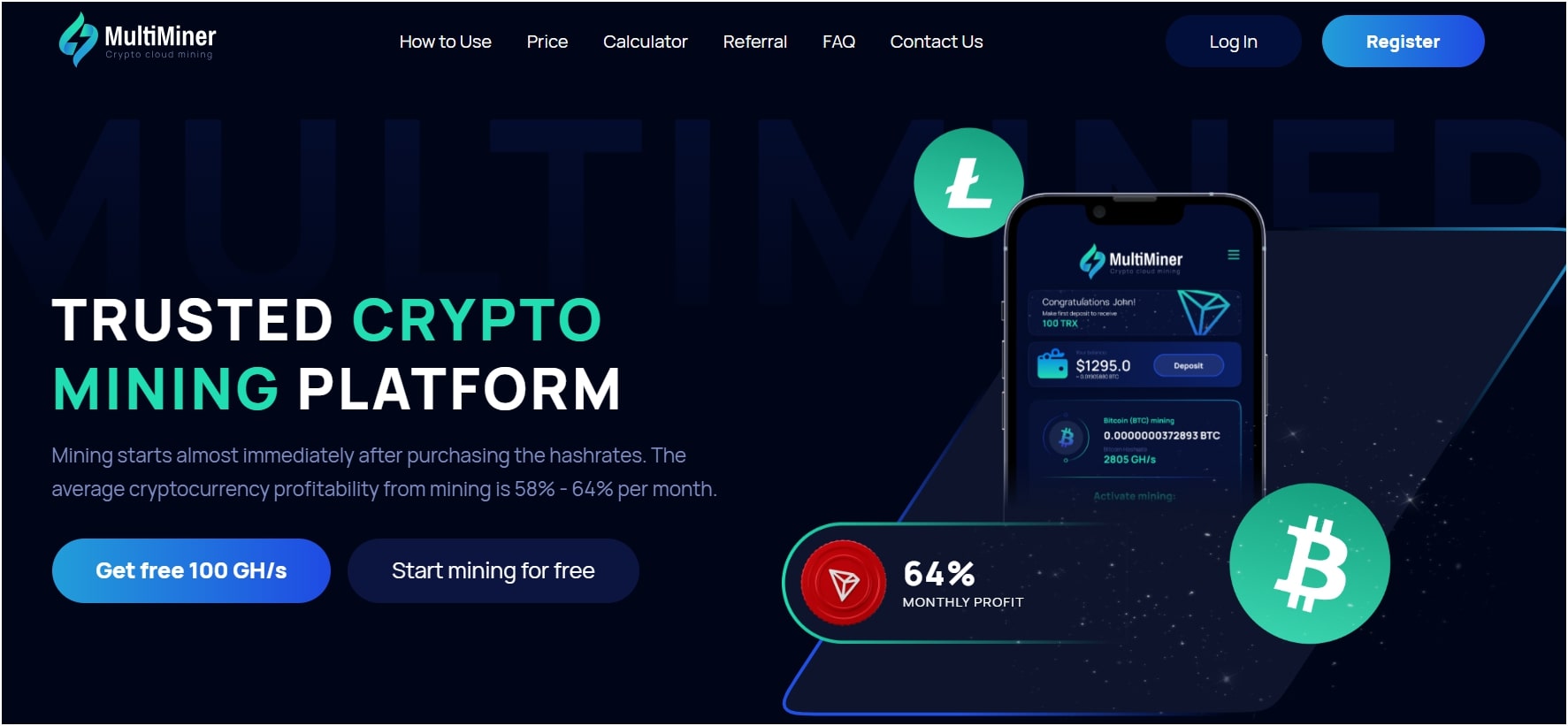
MultiMiner is another top crypto mining software, and it is perfect for people who want a friendly interface. It was launched in 2013 by developer Nate Woolls, and it’s built on top of the BFGMiner engine. So, you get the same power of BFGMiner without the complexity of command‑line commands.
MultiMiner is free to use and works on Windows out of the box. Also, Mac and Linux require extra packages, but there are installation guides to help.
Graphical user interface: MultiMiner displays your mining devices and lets you choose which coin to mine with simple clicks. A getting‑started wizard walks you through installation and configuration. So, that’s great if you’re new and don’t want to memorize commands.
Automatic profitability switching: Its software can scan multiple algorithms like SHA‑256, Scrypt, and Ethash, and then it can automatically mine the most profitable coin based on current prices and difficulty. Basically, you don’t have to monitor markets constantly, and you can even set up manual strategies if you prefer.
Supported cryptocurrencies: MultiMiner can be used to mine Bitcoin, Litecoin, Ethereum Classic, Monero, Zcash, Dogecoin, Dash, and others.
4. Awesome Miner
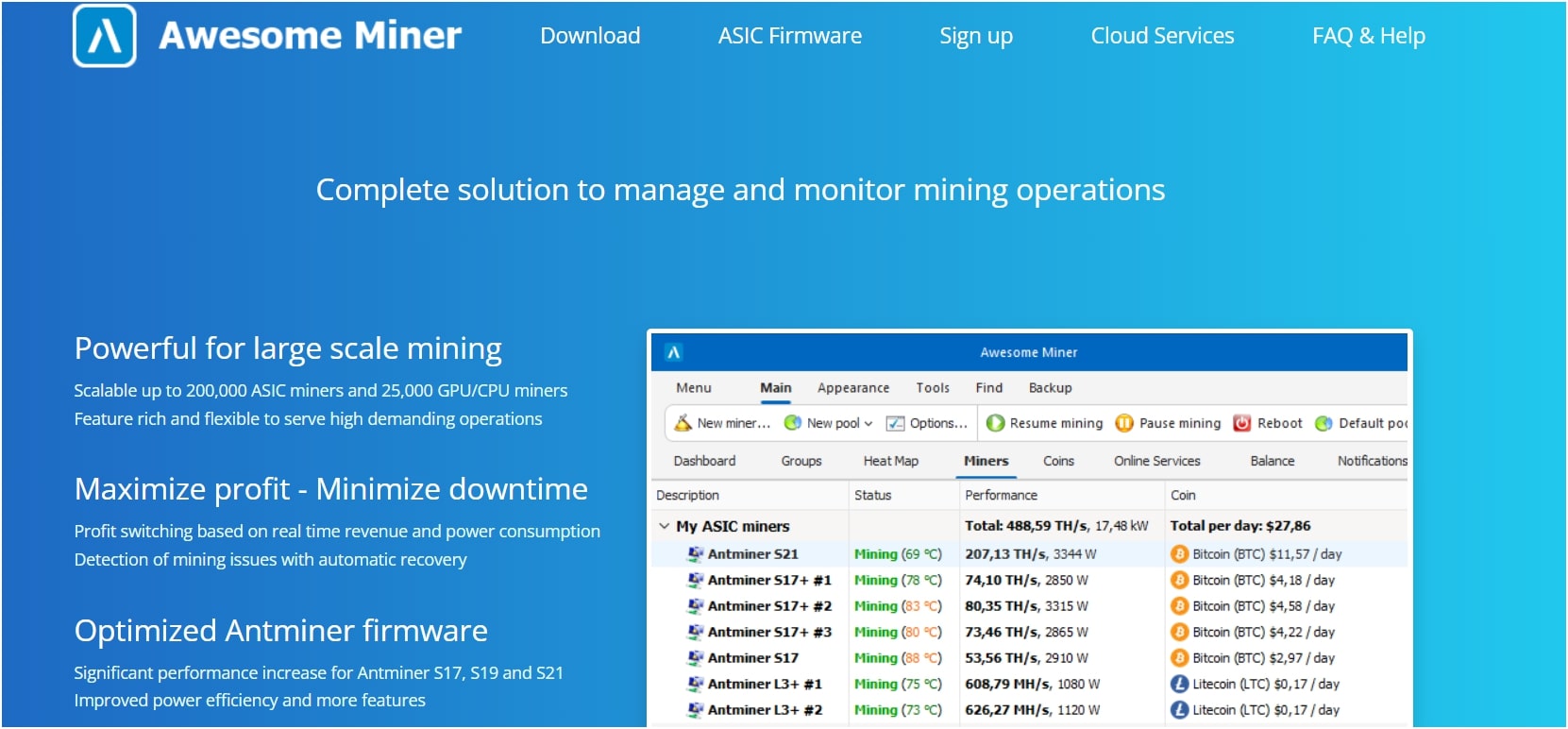
Awesome Miner is more than just mining software; it’s basically a management platform. It was mainly developed by IntelliBreeze in 2014, and this program lets you control and monitor multiple mining rigs from a single dashboard. Hence, that’s actually ideal for hobbyists with several devices or professionals running large farms.
Well, you need to note that the free version of Awesome Miner covers up to two miners, and beyond that, you’ll pay a small fee per device. But yes, it’s worth the cost if you want robust controls.
Large‑scale management: Awesome Miner can handle up to 200,000 ASICs and 25,000 GPU or CPU miners. It supports over 50 mining engines, including CGMiner, BFGMiner, and SGMiner. So, if you run different hardware brands, the platform brings everything together.
Profitability switching: Similar to MultiMiner, Awesome Miner also offers auto‑profit switching, and it works with mining pools and marketplaces, checking current prices and difficulties to pick the best algorithm for your hardware. You can even override the selections if you have a good, profitable strategy.
Supported cryptocurrencies: There are numerous cryptocurrencies that are compatible with Awesome Miner, such as Bitcoin, Litecoin, Ethereum Classic, Monero, Zcash, Dogecoin, Dash, Ravencoin, Bitcoin Gold, and many more.
5. EasyMiner
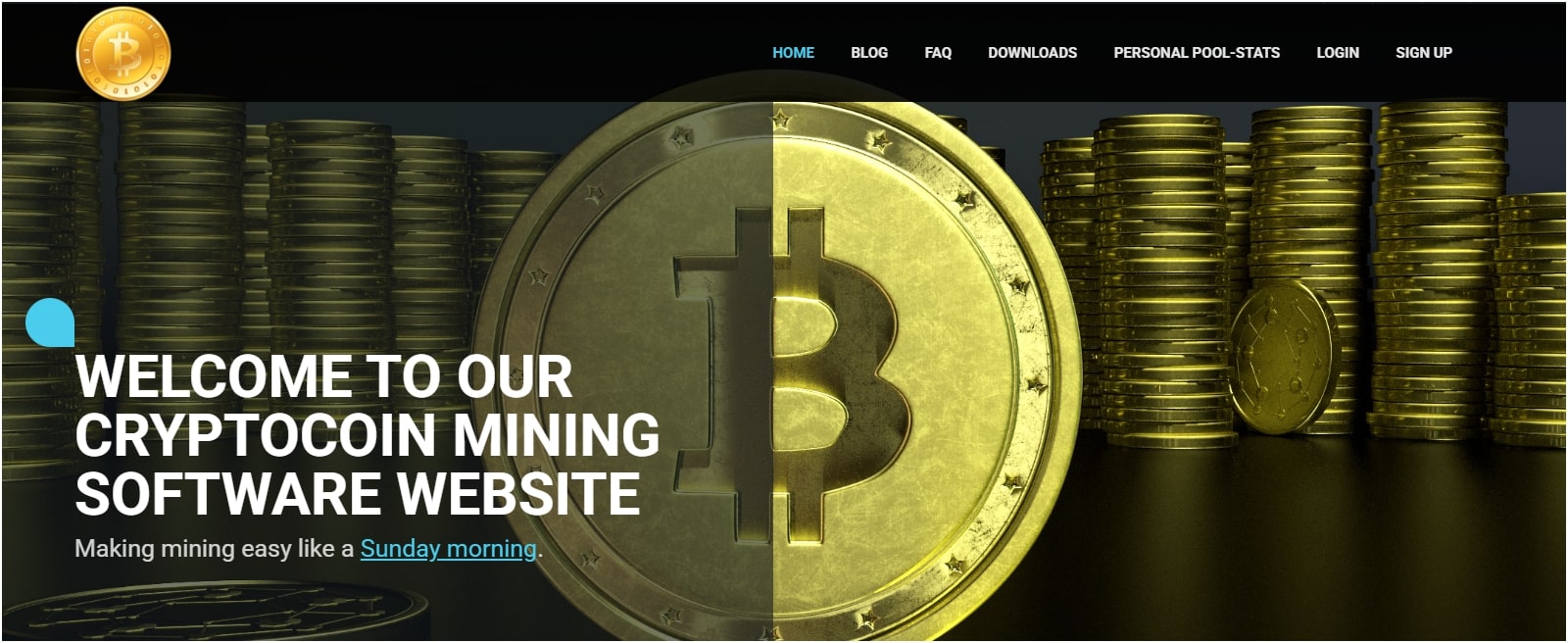
EasyMiner is another one of the best crypto mining software, and it’s basically a graphical front end for CPUMiner, CGMiner, and other engines. You don’t need to edit configuration files; everything is done through a clear interface. Actually, EasyMiner works only on Windows, which simplifies support but limits cross‑platform use. It supports ASICs, GPUs, and CPUs.
Visual dashboard: EasyMiner’s dashboard shows hash rates, earnings, and temperature. You can even monitor performance in real time without typing commands, and it also includes price feeds, so you can see how much your mined coins are worth.
Solo and pool modes: Well, if you want to mine alone, there’s a “Solo” mode. But, for better odds, you can also join a pool. The software lets you select pools easily, and you can also choose your own hash algorithm depending on the coin you want to mine.
Supported cryptocurrencies: EasyMiner primarily supports Litecoin (LTC) mining through its MoneyMaker mode, but its Classic mode also allows users to mine Bitcoin (BTC) and some other cryptocurrencies that use the SHA-256 and Scrypt algorithms.
6. Kryptex Miner

Kryptex Miner is best because it turns almost any Windows PC into a mining machine. You can install the software, and it automatically benchmarks your system to decide which algorithms yield the best results. Then, Kryptex mines coins like Bitcoin, Ethereum Classic, or Ravencoin and pays you in cryptocurrency or fiat money, whichever you want.
Kryptex is mainly for Windows; although the company mentions Linux and macOS support, it’s still limited. It also charges withdrawal fees, and there’s a minimum payout threshold, depending on coins, but it’s around $10.
Profitability detection: Kryptex monitors coin prices and mining difficulty. Then, it automatically swaps between algorithms like Ethash and KawPoW to maximize earnings. Hence, you don’t need to choose or adjust anything manually.
Flexible payouts: You can withdraw your rewards as Bitcoin, Ethereum, Litecoin, USDT, or even convert them to fiat and deposit them to a bank card.
Supported cryptocurrencies: Kryptex supports mining Bitcoin, Ethereum, Monero, Zcash, and other cryptocurrencies by automatically selecting the most profitable algorithms.
7. Mobile Miner
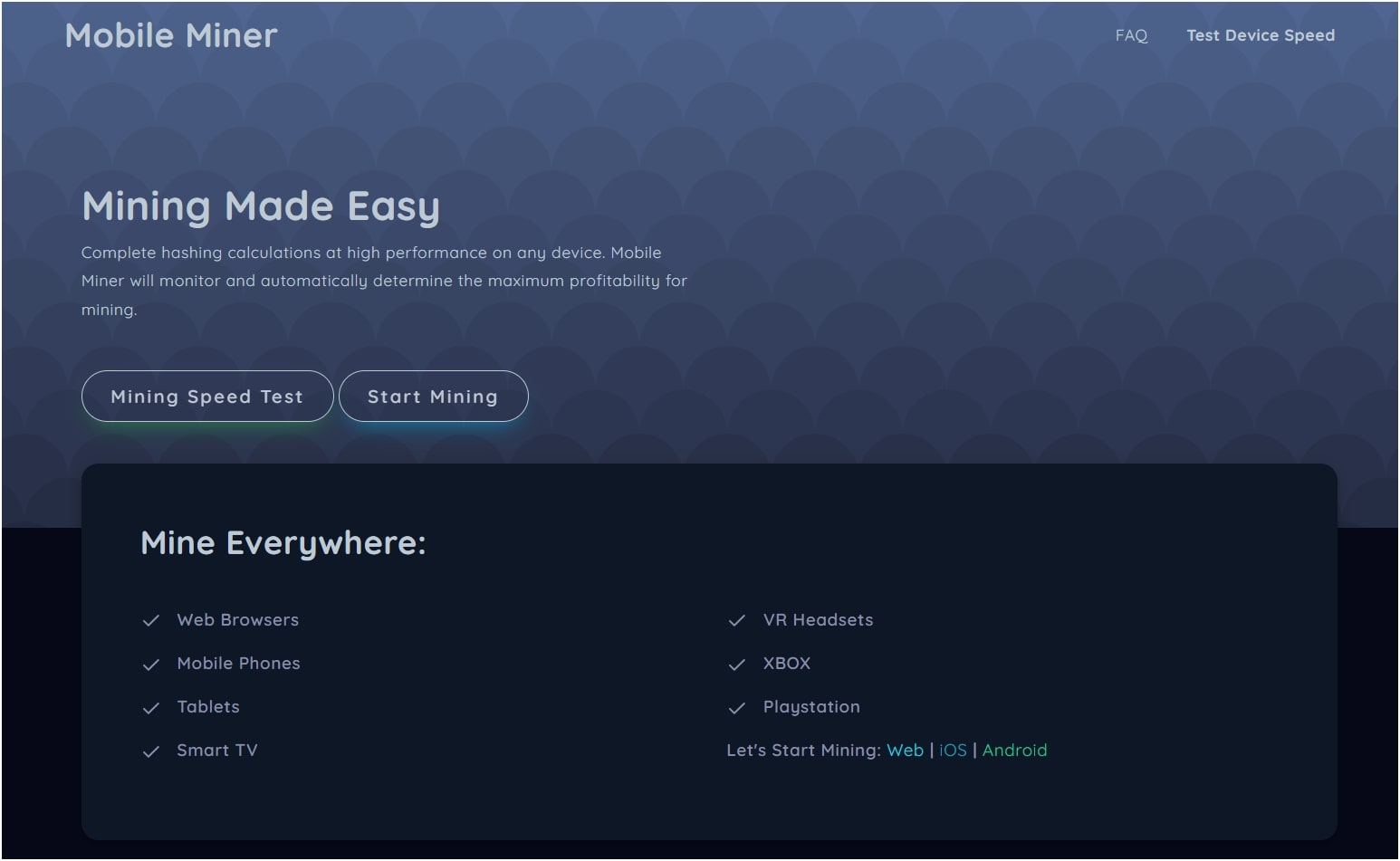
Mobile Miner is the best crypto mining software for smartphone users. It’s basically a web‑based application that runs on almost any device with a browser: phones, tablets, consoles, even smart TVs. Here, the idea is to use your idle devices to mine coins with minimal setup.
MobileMiner isn’t a traditional ASIC‑based solution. It currently connects to the MoneroOcean pool, meaning it is best for privacy‑focused coins like Monero, and then pays out to your crypto wallet. Because mobile devices are less powerful, you should expect small earnings only.
Device agnostic: You can start mining in a web browser or by downloading the app for iOS and Android. The platform also supports tablets, smart TVs, Xbox, and PlayStation. Hence, this flexibility means you can mine on gadgets you already own.
Easy account management: MobileMiner uses a free account system. So, you create an account to manage wallet addresses, and then, each device you add will deposit earnings into your designated wallet. You can easily view mining status by visiting a dashboard and entering your wallet address.
Supported cryptocurrencies: Mobile Miner supports a wide variety of cryptocurrencies, including Monero, Bitcoin, Litecoin, and many other coins.
8. Cudo Miner
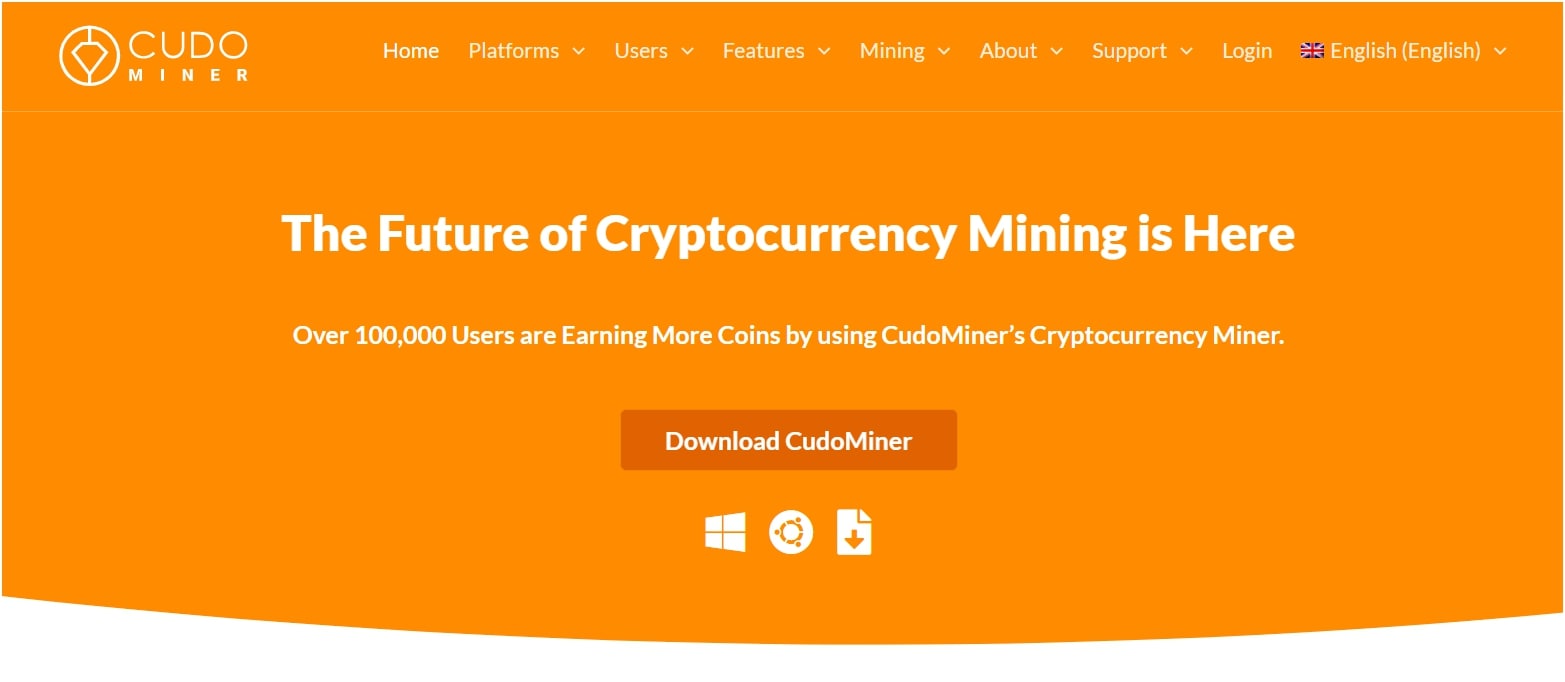
Cudo Miner is the mining software best suited for both beginners and professional mining farms. Its user interface is accessible, but it also offers advanced controls when you need them. The platform runs on Windows and Linux, and there is also its own optimized operating system, CudoOS.
Cudo Miner supports CPU, GPU, FPGA, and ASIC hardware, and it even pauses automatically when you start gaming or doing heavy tasks on your computer, then resumes when idle.
Automated benchmarking: When you install Cudo Miner, it generally analyzes your hardware and selects the most profitable coin and algorithm. Then, it keeps benchmarking in the background to adapt to market changes. You can choose to get paid in various cryptocurrencies or convert earnings to dollars or gift vouchers.
Advanced management with Cudo Farm: Cudo Farm is a feature mainly designed for mining farms. Here, it gives you centralized control over thousands of devices. Tools like intelligent profit switching, forecasting, and automation help maximize returns. You can even set templates for different rigs and apply them across your network.
Supported cryptocurrencies: Cudo Miner supports automated mining for Bitcoin Gold (BTG), Ethereum (ETH), Ethereum Classic (ETC), Monero (XMR), and Ravencoin (RVN). It also supports manual mining for other PoW coins.
9. NiceHash
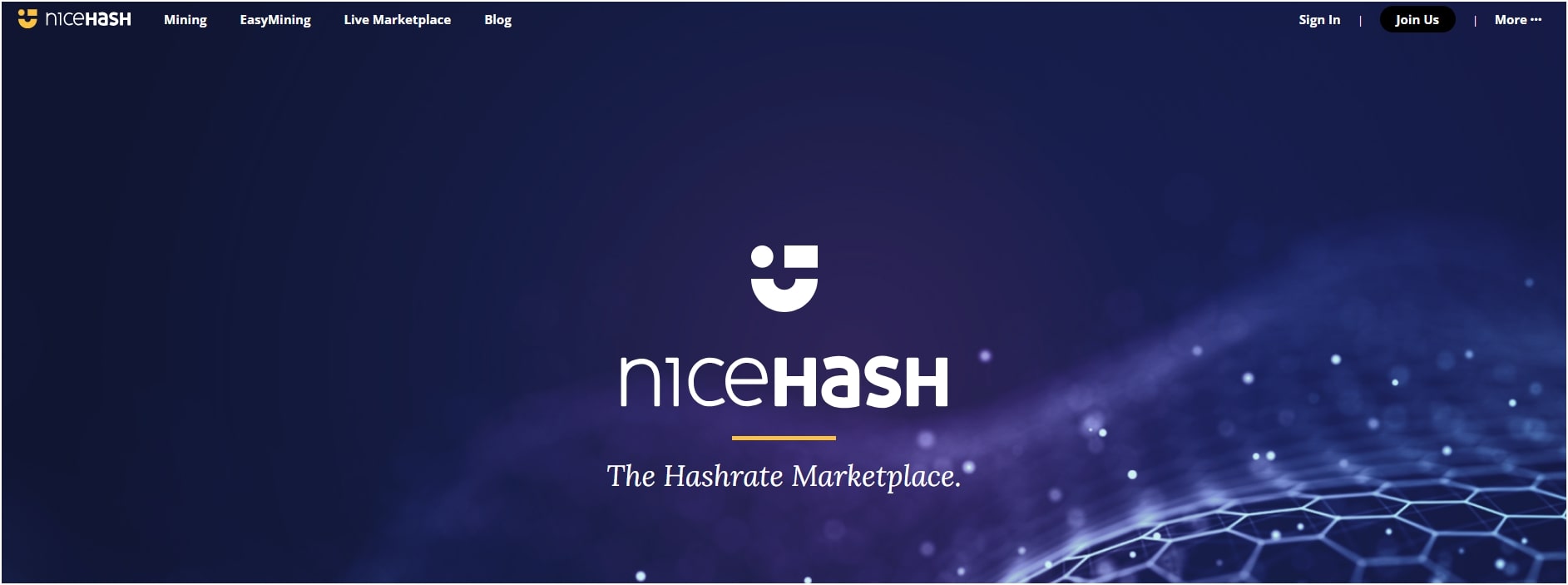
NiceHash is a unique platform that combines mining software with a marketplace for hash power. So, instead of only mining yourself, you can also sell your computing power to others or buy additional power if you want to mine more. NiceHash supports ASICs, GPUs, and CPUs, and runs on Windows and Linux.
Hash power marketplace: Miners can sell spare computing power to buyers on NiceHash, and buyers can use that power to mine specific coins. Payments are handled automatically. Hence, this system lets you earn BTC even if you’re not directly mining a particular coin.
Automatic algorithm switching: NiceHash’s software scans up to 30 algorithms and switches to the most profitable one. It benchmarks your hardware first, so you know expected earnings. Plus, there’s also a built‑in profitability calculator that helps you estimate income based on your hash rate and electricity costs.
Supported cryptocurrencies: NiceHash users can mine various cryptocurrencies, including Bitcoin, Litecoin, Dogecoin, Bitcoin Cash, Ravencoin, and Kaspa. Also, with NiceHash QuickMiner, users can even mine Ethereum, Ethereum Classic, and Ergo.
What Is Crypto Mining Software?
The crypto mining software is the bridge between your hardware and the blockchain network. You can think of it as a translator. Your hardware, whether it’s an ASIC, GPU, CPU, or even a mobile device, needs instructions on how to solve the mathematical puzzles that secure cryptocurrencies. Basically, mining software sends these instructions, receives the results, and communicates with the blockchain to submit proof of work.
Crypto mining software controls how efficiently your hardware operates, and some programs are inefficient, wasting power with poor optimization. But many others are optimized, squeezing out every extra hash to boost returns. Hence, the difference can mean the gap between earning a profit and losing money on electricity. Plus, mining software also manages connections to pools, monitors temperatures, and even tracks your rewards.
Now, there is also some free software. Basically, the term Bitcoin mining software free describes programs like CGMiner and BFGMiner that don’t cost anything to download, and while the software is free, you still have to pay for hardware and electricity.
Well, to understand crypto mining software better, let’s picture a simple entity graph:
Crypto Mining Software: The central node connects your hardware to a blockchain network. Blockchain: The distributed ledger; mining software sends computed hashes here to validate transactions. Proof‑of‑Work: The mechanism that proves you’ve done the work; mining software helps your hardware solve this. Software → Hardware: crypto mining software interacts with hardware like GPUs, ASICs, FPGAs, and CPUs to perform calculations efficiently.What is the Best Bitcoin and Crypto Mining Software?
The best Bitcoin and crypto mining software are CGMiner, BFGMiner, MultiMiner, Awesome Miner, EasyMiner, Kryptex Miner, MobileMiner, Cudo Miner, and NiceHash.
The top mining software tools, such as CGMiner and BFGMiner, are actually well-known for being open-source and powerful, and for those new to the process, MultiMiner and EasyMiner are available as user-friendly graphical interfaces. Kryptex is basically designed for Windows computers, and it’s free.
MobileMiner is good for Android and iOS users. Also, you can use Cudo Miner, which is a good choice for people who want both ease of use and advanced functions, while NiceHash includes a marketplace for buying and selling hash power.
Why Choose the Best Bitcoin and Crypto Mining Software?
You should choose the best Bitcoin and crypto mining software for better efficiency and profitability. You know, mining isn’t just about plugging in a machine. The software you pick basically determines your efficiency, profitability, and even your security. Hence, high‑quality software will generally maximize hash rates, monitor temperatures, and prevent downtime. And that leads to more coins mined per watt of electricity.
Secondly, good software eventually reduces setup headaches, and beginners benefit from guided installers and dashboards that explain what’s happening. So, when you choose a well‑supported application, you’re less likely to encounter bugs or vulnerabilities.
Finally, you should know that profitability depends on algorithm switching as well. Hence, software like Cudo Miner and NiceHash automatically switches to the most profitable algorithm. So, without this, you might waste time on a less rewarding coin. Picking the best program means staying ahead of the market and getting paid more for the same amount of work.
What Are the Popular Types of Crypto and Bitcoin Mining Software?
The popular types of crypto mining software are for ASIC, GPU, CPU, FPGA, and then there are options for pool mining, solo mining, cloud mining, and merged mining.
| Type | Features | Pros | Cons | Best For |
| ASIC Miner Software | Supports SHA-256, high hash rates like 200 TH/s | Fast, energy-efficient | Expensive hardware, limited to a few coins | Serious Bitcoin miners |
| GPU Mining Software | Handles multiple algorithms, 50 MH/s average | Flexible for altcoins, cheaper entry | Higher power use | Mining altcoins |
| CPU Mining Software | Uses processor power, 10 MH/s typical | No extra hardware needed, low cost | Slow earnings, under 1 dollar daily | Beginners testing the waters |
| FPGA Mining | Customizable boards, 100 MH/s | Efficient tweaks, lower heat | Complex setup, rare hardware | Advanced tech users |
| Pool Mining | Pools share rewards | Pools steady payouts | Pool fees are quite high, 1-2% | Users without hardware |
| Cloud Mining Software | Rent power online | Easy start, no noise | Scams are common, with 5-10% fees | No-home-setup folks |
| Merged Mining | Mine’s two coins at once | Double earnings, efficient | Limited pairs, like Bitcoin+Namecoin | Multi-coin hunters |
| Mobile or Laptop Mining | Phone CPU/GPU, low 1 MH/s | Portable, free apps | Battery drain, tiny profits | Casual earners |
| Self-Hosted Mining Solutions | Self at home | Full control over devices | Very high bills, tedious maintenance | Home set up miners |
ASIC Miner Software for High-Efficiency Mining
ASIC miner software is designed specifically for devices built to mine Bitcoin. ASIC mining is the most powerful way to mine BTC. The best examples include CGMiner.
Generally, these programs let you set fan speeds, control voltages, and monitor temperatures. By dialing in these settings, you can extract maximum hash rate from your ASIC. Many ASIC miners today push well over 300 terahashes per second.
GPU Mining Software for Versatile Crypto Options
GPU mining software, like MultiMiner and NiceHash QuickMiner, uses your graphics cards to solve hashing algorithms. They’re really good at parallel computations and can mine coins like Ethereum Classic, Ravencoin, or Dogecoin.
Usually, the software has overclocking options so you can fine-tune memory and core frequencies. It also might have an auto-profit switching feature to jump between algorithms based on the market. Remember, GPU mining is still a thing for hobbyists since GPUs are easier to sell than ASICs if the market changes.
CPU Mining Software for Entry-Level Users
CPU mining software just uses your computer’s main processor, and can mine less-intensive coins like Monero. CPU mining isn’t competitive for Bitcoin, but it can be a useful learning tool.
Since CPUs are in most desktops and laptops, this kind of software is good for beginners who want to understand mining without buying expensive hardware. But, you shouldn’t expect to make a lot of money, maybe pennies a day, but the costs are also low.
FPGA Mining and Advanced Configurations
FPGAs, which stand for Field-Programmable Gate Arrays, are chips that can be programmed to run specific algorithms. So, the mining software for FPGAs, such as BFGMiner modules, allows you to customize the logic to match the algorithm you’re mining.
Hence, this flexibility can make them more efficient than GPUs while using less power than ASICs. But FPGAs are complex to set up, so they’re mostly used by people who enjoy experimenting or advanced users.
Pool Mining vs. Solo Mining Software
Pool mining software links your hardware to a mining pool, and then the pool divides the work among a bunch of miners and shares rewards based on contributions. Most miners pick pools because the chances of getting consistent payments are much higher than solo mining.
On the other hand, Solo mining software connects directly to the blockchain and competes for blocks on its own. So, unless you control a large part of the network’s hash rate, solo mining results are really unpredictable.
Cloud Mining Software and Hashrate Marketplaces
Cloud mining software generally interacts with remote data centers that rent out computing power. For example, platforms like NiceHash and Cudo Miner let you buy or sell hash power without owning any hardware.
So, you just have to pay a contract fee, and the mining happens on someone else’s machines. This method gets rid of maintenance tasks, but it has risks: your profits depend on the contract terms and market prices. Hence, always check things like contract lengths, fees, and the provider’s reputation before you rent a hash rate. You can also read our Binance cloud mining review.
Merged Mining for Multiple Cryptos
Merged mining lets you mine two or more cryptocurrencies at the same time if they use the same algorithm. For example, miners can mine Namecoin along with Bitcoin because they both use SHA-256.
Merged mining software works with pools that support this feature, and it boosts your earnings by getting rewards from secondary chains without using extra electricity. But again, not all software supports this, so check for compatibility if you want to get the most out of your mining.
Mobile or Laptop Mining with Legit Crypto Mining Apps
Apps like Mobile Miner bring mining to devices that aren’t usually powerful. These applications are simple to install and often run in browsers.
Mainly, they use idle CPU cycles and sometimes GPUs to mine coins like Monero or CoinHive tokens. While the income is minimal, mobile mining apps are a low-risk way for people to learn about cryptocurrency, and they’re also a kind of creative way to use old hardware.
Self-Hosted vs. Hosted/Colocation Mining Solutions
Self-hosted software runs on your own machines at home or in a data center. So, only you are responsible for the electricity, cooling, and maintenance.
Hosted or colocation solutions mean you send your hardware to a facility where professionals manage it. You just need to pay a fee, and they handle the setup, cooling, and network. NiceHash’s marketplace is a type of hosted mining because you’re renting power from remote machines.
How to Pick the Best Crypto Mining Software?
To pick the best crypto mining software, you should think about your hardware type, skill level, profitability features, fees, licenses, security, community support, and testing capabilities.
Match the tool to your hardware: If you’re running ASICs, for instance, you’ll want software that’s built just for that, like CGMiner or the firmware from the company that made the hardware. But again, if you’re using GPUs, it’s probably best to look for programs with algorithm switching, like MultiMiner or NiceHash QuickMiner. And for anyone who’s just doing some CPU mining, you can get started with something like EasyMiner. Consider your skill level: A beginner might want a simple graphical interface and an easy setup. So, in that case, EasyMiner, Kryptex, and NiceHash are good options because they have a one-click install and a dashboard that’s really easy to figure out. More experienced users, though, might prefer command-line tools like BFGMiner or CGMiner since they offer a lot more control. Check profitability features: It’s smart to check out the profitability features, too. You know, things like auto-switching can really help boost your earnings. Cudo Miner, Awesome Miner, and NiceHash automatically pick the best algorithm and coin. And if your electricity costs are high, you should choose software that helps you keep an eye on power usage and allows you to change frequencies. Look at fees and licenses: A lot of these tools are free, but some have premium features or charge you per miner. For example, the advanced version of Awesome Miner costs about $2 per ASIC each month after the free part is over. Also, NiceHash takes a percentage of the transactions on its marketplace. So, it’s actually a good idea to understand all the costs before you commit to anything. Research security and community support: You should always download software from the official websites, not some random place. Also, open-source programs with active communities, like CGMiner, get updates and patches all the time. So, just stay away from obscure or unverified software that might contain malware. Test and iterate: You know, no single piece of software is perfect for everyone, so try a few different options with small test runs. See how they compare on things like hash rates, energy usage, and how easy they are to use. Once you find the one that works best for your hardware and meets your needs, you can easily set it up on all your rigs.Can I Mine 1 Bitcoin a Day?
No, it’s practically impossible to mine 1 Bitcoin per day. Today, the Bitcoin network’s difficulty is higher than ever. You know, after the 2024 halving, miners receive 3.125 BTC per block. So, around 144 blocks are mined daily, meaning the entire network produces about 450 BTC each day.
To mine 1 BTC per day, you’d need about one four‑hundred‑and‑fiftieth of the total network hash rate. As of today, the Bitcoin network hash rate hovers near 950 exahashes per second (950 EH/s). One exahash equals one quintillion hashes per second (1×10²⁰ h/s). One four‑hundred‑and‑fiftieth of 950 EH/s is about 2.1 EH/s. Now, to put that in perspective:
A modern ASIC like the Antminer S21 Pro runs at roughly 335 terahashes per second (TH/s). One exahash equals one million terahashes (1 EH/s = 1,000,000 TH/s). To reach 2.1 EH/s, you’d need about 2.1 million TH/s. Dividing that by 335 TH/s per machine means you’d require roughly 6,300 Antminer S21 Pro units.Again, besides the hardware cost, you’d need massive power and cooling infrastructure. Because each S21 Pro consumes around 5,360 watts. Multiply that by 6,300 units and you’re looking at more than 33 megawatts of power. Now, that’s equivalent to the electricity usage of a small town.
Hence, the capital required runs into tens of millions of dollars. So, unless you operate an industrial‑scale farm with cheap electricity and thousands of ASICs, mining one Bitcoin per day isn’t feasible. Also, to store your mined crypto, you can check out our guide on the best crypto wallets.
Which Crypto Mining Software Is Most Profitable?
CGMiner, BFGMiner, MultiMiner, and Awesome Miner are some of the most profitable crypto mining software today. But profitability isn’t determined solely by the software; hardware efficiency, electricity price, and coin prices are all crucial.
CGMiner and BFGMiner are great for ASICs and give you full control over settings, helping you squeeze extra efficiency. MultiMiner is easy if you want auto-switching for the best profit coins. Awesome Miner is good for big setups, managing many rigs from one dashboard. If you are not sure how regulations affect your crypto mining profits, you can read our guide on the crypto regulations around the US and Europe.
The post Best Cryptocurrency Mining Software: Top Picks for Profitable Bitcoin Miners in 2025 appeared first on CryptoNinjas.














 Bengali (Bangladesh) ·
Bengali (Bangladesh) ·  English (United States) ·
English (United States) ·